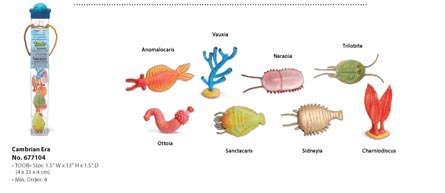Ordovician Meteor Blast Led to Explosion of Life
Many people may be aware of the impact of an extraterrestrial object on the destruction of many forms of life on Earth, such as the huge asteroid collision that aided and abetted the demise of the dinosaurs 66 million years ago. However, asteroids and meteor collisions may have had a deeper impact on life on Earth than previously thought. Indeed, such natural catastrophes could have helped “spur on” evolution and led to an increase in diversity of Paleozoic life.
Scientists have found evidence to suggest that an increase in Ordovician life forms may be due to a bombardment of extraterrestrial objects about 470 million years ago. The researchers have hypothesised that the disintegration of a huge asteroid meant that planet Earth was repeatedly struck by fragments of rock at a vital stage in the evolution of life on Earth.
Palaeozoic Life
The theory that such impacts may have kick-started evolution and led to an acceleration in the evolution of animal families is set out in a new book – “Incoming” by Ted Nield, editor of Geoscientist, the journal of the Geological Society of London.
Dr Nield, a geologist by training stated:
“The picture emerging from new research is that around 470 million years ago a stupendous collision in the asteroid belt [between Mars and Jupiter] bombarded the Earth with meteorites and this may have been responsible for the single greatest increase in biological diversity since the origin of complex life.”
Book Based on Extensive Studies
The book “Incoming” or “Why we should stop worrying and learn to love the meteorite”, is based on the extensive studies carried out by Professor Birger Schmitz of the University of Lund (Sweden). He analysed rock samples taken from five Swedish quarries, finding that in strata dating from around 470 million years ago there was a massive concentration of fossilised meteorites. The concentration was over 100 times what would have been expected under “normal” meteorite bombardment conditions.
Professor Schmitz commented:
“The original asteroid that broke up was perhaps a few hundred kilometres in diameter so there were a lot of fragments. The size would have been up to 10 kilometres across, roughly the same diameter as the one that wiped out the dinosaurs.”
The professor added:
“We think that there were quite a few really big impactors and these would have had the power to change life on Earth.”
Professor Schmitz has travelled to other parts of the world, testing his theory regarding the increased concentration of fossilised meteorites in Ordovician strata. He has recorded similar increases in meteorite fragment concentrations, reaffirming the results of his work in Sweden.
There may be a body of evidence to suggest that our planet was bombarded by space debris around 470 million years ago, planet Earth has been hit by such bodies on numerous occasions in its 4.7 billion year history. Indeed, some scientists consider such impacts inevitable describing near space around our planet as a “cosmic shooting gallery”. The point to consider is this – did these impacts in the Ordovician result in the sudden increase in life forms seen in the fossil record of Ordovician strata?
On this point, Professor Schmitz is more cautious, stating:
“The theory is controversial because most scientists believe that meteorite impacts cause extinction. This is true, but 470 million years ago diversity was pretty low – so there were far fewer species to wipe out. Our theory is that the impacts changed the climate and geology of the Earth and that species had to adapt rapidly to big changes or go extinct.”
To read another article on how extraterrestrial impacts could have affected life on Earth: Jurassic explosion could have led to the demise of the Dinosaurs.
During the Ordovician Period (lasting from around 488 million years ago to 443 million years ago), the nature of marine faunas changed dramatically. Cambrian faunas were replaced with a more diverse assemblage in the mid-Ordovician and the first animals began to colonise the land (arthropods). The end of the Ordovician is marked by the first major extinction event recorded in the fossil record. Many types of arthropod, notably trilobites and other forms of marine life such as the brachiopods, graptolites and corals became extinct.
Following the “Cambrian explosion” – a rapid diversification of marine life that occurred some 80 million years before the Ordovician meteorite bombardment, the fossil record shows a relative lull in the speed of evolution. However, from the Dapingian faunal age (at around 471 million years ago) there is evidence to suggest a burst of evolution. This has been recorded in the fossil record. This increase in diversity coincides with the meteor impacts – could the impacts have acted as a catalyst to speed up evolutionary development?
Typical Cambrian Biota

The model set pictured (above) is the Wild Safari Dinos Cambrian life tube.
To view this range of prehistoric animal models: Wild Safari Dinos Models.
Widespread Devastation
The impacts would have brought about local, widespread devastation, altering environments and effecting the climate. These exogenous forces would have led to the demise of some types of animal but created opportunities for others. The break up of the asteroid and the resulting collisions with Earth could have given evolution a kick start. It changed the evolution of Palaeozoic life.
At this time in Earth’s history, the most advanced vertebrate creatures on the planet were primitive, jawless fishes. Eight groups of these fossil fish have been identified in the fossil record (agnathans), these types of vertebrate diversified and could have benefited from the meteor impacts, thus spurring on vertebrate evolution. Invertebrates may also have perversely benefited from the extraterrestrial interventions with more advanced cephalopods and arthropods evolving, perhaps even the motivation to colonise the land was in part dictated by conditions that arose as a result of the meteorite bombardments.






Leave A Comment